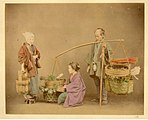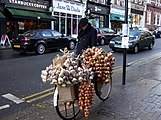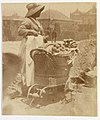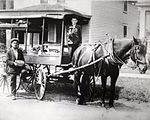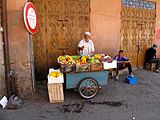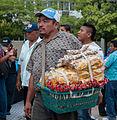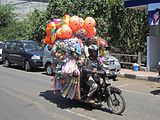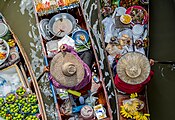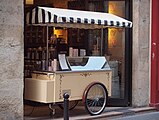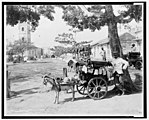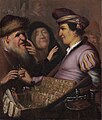Peddler
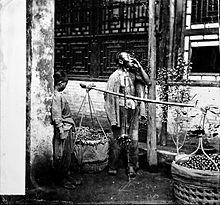
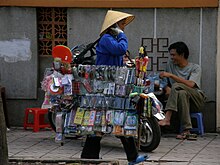
A peddler (American English) or pedlar (British English)[a] is a door-to-door and/or travelling vendor of goods. In 19th-century America the word "drummer" was often used to refer to a peddler or traveling salesman; as exemplified in the popular play Sam'l of Posen; or, The Commercial Drummer by George H. Jessop.[2]
In England, the term was mostly used for travellers hawking goods in the countryside to small towns and villages. In London, more specific terms were used, such as costermonger.
From antiquity, peddlers filled the gaps in the formal market economy by providing consumers with the convenience of door-to-door service. They operated alongside town markets and fairs where they often purchased surplus stocks which were subsequently resold to consumers. Peddlers were able to distribute goods to the more geographically-isolated communities such as those who lived in mountainous regions of Europe. They also called on consumers who, for whatever reason, found it difficult to attend town markets. Thus, peddlers played an important role in linking these consumers and regions to wider trade routes. Some peddlers worked as agents or travelling salesmen for larger manufacturers and so were the precursor to the modern travelling salesman.
Images of peddlers feature in literature and art from as early as the 12th century. Such images were very popular with the genre and Orientalist painters and photographers of the 18th and the 19th centuries. Some imagery depicts peddlers in a pejorative manner, and others portray idealised romantic visions of peddlers at work.
Etymology and definitions
[edit]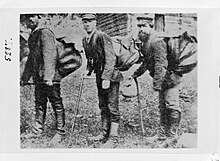
The origin of the word, known in English since 1225, is uncertain, but is possibly an Anglicised version of the French pied, Latin pes, pedis "foot", referring to a petty trader travelling on foot.
A peddler, under English law, is defined as: "any hawker, pedlar, petty chapman, tinker, caster of metals, mender of chairs, or other person who, without any horse or other beast bearing or drawing burden, travels and trades on foot and goes from town to town or to other men's houses, carrying to sell or exposing for sale any goods, wares, or merchandise immediately to be delivered, or selling or offering for sale his skill in handicraft."[4][5] The main distinction between peddlers and other types of street vendor is that peddlers travel as they trade, rather than travel to a fixed place of trade. Peddlers travel around and approach potential customers directly whereas street traders set up a pitch or a stall and wait for customers to approach them. When not actually engaged in selling, peddlers are required to keep moving. Although peddlers may stop to make a sale, they are precluded from setting up a pitch or remaining in the same place for lengthy periods. Although peddlers normally travel by foot, there is no reason why they cannot use some means of assistance, such as a cart or a trolley, to assist in the transportation of goods.
History
[edit]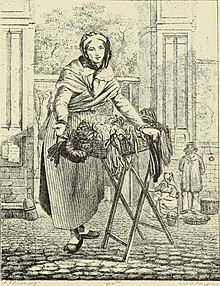
Peddlers have been known since antiquity. They were known by a variety of names throughout the ages, including Arabber, hawker, costermonger (English), chapman (medieval English), huckster, itinerant[7] vendor or street vendor. According to marketing historian, Eric Shaw, the peddler is "perhaps the only substantiated type of retail marketing practice that evolved from Neolithic times to the present."[8] The political philosopher John Stuart Mill wrote that "even before the resources of society permitted the establishment of shops, the supply of [consumer] wants fell universally into the hands of itinerant dealers, the pedlars who might appear once a month, being preferred to the fair, which only returned once a year."[9]
Typically, peddlers operated door-to-door, plied the streets or stationed themselves at the fringes of formal trade venues such as open air markets or fairs. In the Greco-Roman world, open-air markets served urban customers, while peddlers filled in the gaps in distribution by selling to rural or geographically distant customers.[10]
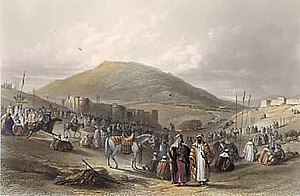
In the Bible the term 'peddler' was used to describe those who spread the word of God for profit. The book of Corinthians has the following phrase, "For we are not as so many, peddling the word of God" (Corinthians 2:17). The Greek term translated "peddling" referred to small-scale merchant who profited from acting as a middleman between others.[11] The Apocrypha has the following, "A merchant shall hardly keep himself from doing wrong; and an huckster shall not be freed from sin" (Ecclesiasticus 26:29).
In some economies the work of itinerant selling was left to a greater or lesser extent to nomadic minorities, such as gypsies, travellers, or Yeniche who offered a varied assortment of goods and services, both evergreens and (notoriously suspicious) novelties. In 19th-century USA, peddling was often the occupation of immigrant communities including Italians, Greeks and Jews.[12] The more colourful peddlers were those that doubled as performers, healers, or fortune-tellers.[13]
Historically, peddlers used a variety of different transport modes: they travelled by foot, carrying their wares; by means of a person or animal-drawn cart or wagon or used improvised carrying devices. Abram Goodman, who took to peddling in the US in the 1840s, reports that he travelled by foot, used a sleigh when roads were snowbound and also travelled, with his pack, by boat when traversing longer distances.[14]
As market towns flourished in medieval Europe, peddlers found a role operating on the fringes of the formal economy. During this time it was common to see long-distance peddlers, who sold remedies, potions and elixirs.[15] They called directly on homes, delivering produce to the door thereby saving customers time travelling to markets or fairs. However, customers paid a higher price for this convenience. Some peddlers operated out of inns or taverns, where they often acted as an agent rather than a reseller.
Peddlers played an important role providing services to geographically isolated districts, such as in the mountainous regions of Europe, thereby linking these districts with wider trading routes.[16]
A 16th-century commentator wrote of the:
many pedlars and chapmen, that from fair to fair, from markett to markett, carieth it to sell in horspakks and fote pakks, in basketts and budgelts, sitting on holydays and sondais in chirche porchis and abbeys dayly to sell all such trifells.[17]
By the 18th-century, some peddlers worked for industrial producers, where they acted as a type of travelling sales representative. In England, these peddlers were known as "Manchester men." Employed by a factory or entrepreneur, they sold goods from shop to shop rather than door to door and were thus operating as a type of wholesaler or distribution intermediary.[18] They were the precursors to the modern sales representative. An attempt by Pitt the Younger in 1785 to buy off opposition to a tax on shopkeepers almost led to peddlers in England being banned. Moreover, anti-semitism in eighteenth and nineteenth century England led to negative images of Jewish peddlers. [19]
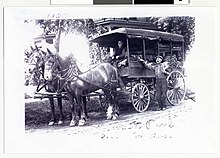

In the United States, there was an upsurge in the number of peddlers in the late 18th century and this may have peaked in the decades just before the American Civil War.[20] However, their numbers began to decline by the 19th century. Advances in industrial mass production and freight transportation as a result of the war laid the groundwork for the beginnings of modern retail and distribution networks, which gradually eroded much of the need for travelling salesmen. The rise of popular mail order catalogues (e.g. Montgomery Ward began in 1872) offered another way for people in rural or other remote areas to obtain items not readily available in local stores or markets. A relatively short-lived upsurge in the number of peddlers was witnessed in the period following the second World War, when the wartime manufacturing boom came to an abrupt end, and returning soldiers finding themselves unable to secure suitable work, turned to peddling which generally offered a decent income.[21]
In the United States, the travelling salesman became a stock character in countless jokes. Such jokes are typically bawdy, and usually feature small town rubes, farmers and other country folk, and frequently another stock character, the farmer's daughter.[22]
Throughout much of Europe, suspicions of dishonest or petty criminal activity was long associated with peddlers and travellers.[23][24] Regulations to discourage small-scale retailing by hawkers and peddlers, promulgated by English authorities in the 15th and 16th centuries and reinforced by the Church, did much to encourage stereotypical and negative attitudes towards peddlers. From the 16th century, peddlers were often associated with pejorative perceptions, many of which persisted until well into the 19th and 20th centuries.[25]
In the modern economy a new breed of peddler, generally encouraged to dress respectably to inspire confidence with the general public, has been sent into the field as an aggressive form of direct marketing by companies pushing their specific products, sometimes to help launch novelties, sometimes on a permanent basis. In a few cases this has even been used as the core of a business.
Life of a peddler
[edit]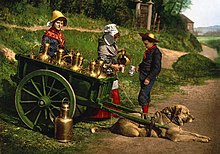
Very few peddlers left written records. Many were illiterate and diaries are rare.[26] Most peddlers handled cash transactions leaving behind few or no accounting records such as receipts, invoices or day-books. However, a very small number of peddlers kept diaries and these can be used to provide an insight into the daily life of a peddler. Ephraim Lisitzky (1885–1962), an immigrant from Russia, arrived in the US in 1900 and took up peddling for a brief period following his arrival. His autobiography, published in 1959 under the title, In the Grip of the Cross-Currents, describes his various encounters with householders and the difficulties he experienced making a sale as door after door was slammed in his face.[27]
After arriving in America in 1842, Abram Vossen Goodman also maintained a diary of his experiences, which has been published by the American Jewish Archives.[28] Excerpts from the diary detail his experiences and thoughts about the life of a peddler. When, Goodman's initial attempts to find employment as a clerk were unsuccessful, he wrote on September 29, "I had to do as all the others; with a bundle on my back I had to go out into the country, peddling various articles." (p. 95) In the first few weeks, he found the lifestyle onerous, uncertain and solitary.
- "Can a man, in fact, be said to be "living" as he plods through the vast, remote country, uncertain even as to which farmer will provide him shelter for the coming night? In such an existence the single man gets along far better than the father of a family. Such fools as are married not only suffer themselves, but bring suffering to their women. How must an educated woman feel when, after a brief stay at home, her supporter and shelterer leaves with his pack on his back, not knowing where he will find lodging on the next night or the night after?" (p.96)
- "Last week in the vicinity of Plymouth I met two peddlers, Lehman and Marx. Marx knew me from Furth, and that night we stayed together at a farmer's house. After supper we started singing, and I sat at the fireplace, thinking of all my past and of my family." (p.100)
- [By October,1842 Goodman is travelling with a brother] "Not far from [Lunenburg] we were forced to stop on Wednesday because of the heavy snow. We sought to spend the night with a cooper, a Mr. Spaulding, but his wife did not wish to take us in. She was afraid of strangers, she might not sleep well; we should go our way. And outside there raged the worst blizzard I have ever seen... After we had talked to this woman for half an hour, after repeatedly pointing out that to turn us forth into the blizzard would be sinful, we were allowed to stay." (p.101)
- "On Monday morning, December 5th, we set out for Groton in a sleigh and at night stayed with an old farmer, about two miles from that place. It was a very satisfactory business day, and we took in about fifteen dollars... After spending Wednesday in Milford, we traveled beyond on Thursday and Friday, spending Saturday at Amherst and Sunday at the home of Mr. Kendall in Mount Vernon. Business, thanks be to God, is satisfactory, and this week we took in more than forty-five dollars. (p. 103)
- "It is hard, very hard indeed, to make a living this way. Sweat runs down my body in great drops and my back seems to be breaking, but I cannot stop; I must go on and on, however far my way lies...Times are bad; everywhere there is no money. This increases the hardship of life so that I am sometimes tempted to return to New York and to start all over again. (pp 107-108)
Modes of transport
[edit]Today, peddlers continue to travel by foot. However, they also use bicycle, hand-held carts, horse-drawn carts or drays and motorized vehicles such as motor-bikes as transport modes. To carry their wares, peddlers use purpose-built back-packs, barrows, hand-carts or improvised carrying baskets. Rickshaw peddlers are a relatively common sight across Asia.
-
Modern-day pedal-powered peddler in Amsterdam, Netherlands, c. 2020
-
Vegetable peddler, Japan, 19th-century
-
Cycle-mounted Breton onion salesmen are a familiar sight across southern England and Wales
-
"Mush-Fakers" and Ginger-Beer Makers, London, circa 1877
-
Fruit peddler and barrow, Sydney, circa 1885
-
Peddler from Russia, circa 1900s
-
A door-to-door peddler, 1905
-
David and Harry Silverman in their fruit-peddling cart, Saint Paul, Minnesota, c. 1920
-
Mandalay rickshaw peddler
-
The Produce Peddler, Fez, Morocco
-
Street vendor in Maracaibo with improvised carry container
-
Banana vendor, Uganda
-
Balloon Salesman
-
Food peddlers are the mainstay of the floating markets in Thailand
-
Ice cream seller in Paris, France 2010
-
Goat wagon peddler, late 19th century
Legislation and regulation
[edit]A number of countries have enacted laws to protect the rights of peddlers, and also to protect the public from the sale of inferior goods. In many states of the US, peddlers are required to apply for a license.[29] India has special laws enacted, by the efforts of planners which give mongers higher rights as compared to other businessmen. For example, mongers have a right of way over motorized vehicles.
In Britain, peddling is still governed by the Pedlars Act 1871, which provides for a "pedlar's certificate". Application is usually made to the police. In the late 20th century, the use of such certificates became rare as other civic legislation including the Civic Government (Scotland) Act 1982 and the Local Government (Miscellaneous Provisions) Act, 1982 for England and Wales introduced a street trader's licence. As of 2008, the pedlar's certificates remain legal and in use, although several local councils have sought to eradicate peddlers by way of local bylaws or enforcement mechanisms such as making them apply for a street trader's licence.
Types and names
[edit]
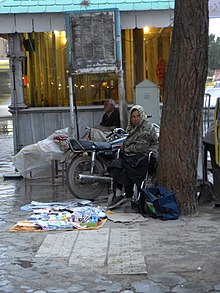

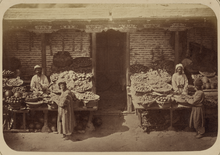
Literal compounds formed from these synonyms are:
- Cheesemonger (cheese)
- Costermonger (apples)
- Fishmonger (seafood)
- Ironmonger (iron wares)
- Upholsterer monger (a peddler of fabrics and stitching)
Metaphoric compounds, since the 16th century mostly pejorative, formed from these synonyms are:
- Disease mongering
- Flesh monger, procurer for prostitution
- Gossip monger (a 'quidnunc')[31]
- Merit-monger, in the 18th century a "do-gooder"
- Power monger
- Rumor monger
- Scandal monger
- Scare monger
- Warmonger, recorded since 1590 (Spenser's Faerie Queene), likely more widespread than any of the literal uses.[clarification needed][citation needed]
Names, most archaic, of product- or industry-specific types of peddlers include:
- Chandler (ship's stores)
- Collier (coal)
- Milliner (hats)
- Lanier (now only a surname, formerly a peddler of wool)
- Cooper (barrels)
Names, some pejorative, of other sub- or supertypes or close relatives of peddlers include:
- Arabber
- Costermonger
- Door-to-door salesman
- Haberdasher
- Hawker
- Huckster
- Pusher
- Merchant
- Seller
- Tout
- Travelling salesman
- Rag-and-bone man
- Street vendor
Individual peddlers (of myth and history)
- Pedlar of Swaffham (English folktale, recorded in 1699)
- James Macfarlan (1832-1862) Scottish poet and peddler
Although there are basic similarities between the activities in the Old World and the New World, there are also significant differences. In Britain, the word was more specific to an individual selling small items of household goods from door to door. It was not usually applied to Gypsies.
- Food traders were normally badgers
- Sellers of chapbooks were chapmen; compare the term stationer which described a bookseller (usually near a university) whose shop was fixed and permanent.
- In Russia a Khodebshchik (Russian: ходебщик) was a person carrying a billboard advertising a product or service, a street hawker or peddler of wares, or house-to-house salesman in the 16th–19th centuries.
In literature and art
[edit]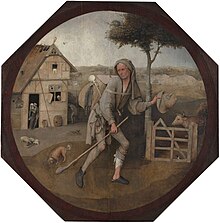
Peddlers have been the subject of numerous paintings, sketches and watercolours in both Western art and in the Orient, where they depict familiar scenes of everyday life. Some of the earliest paintings of peddlers were made in China. The 12th-century Chinese artist, Su Hanchen made several paintings of peddlers as did one of his contemporaries, Li Song, both of whom painted The Knick knack Peddler.
The Wayfarer by Hieronymous Bosch is perhaps the most iconic image of a peddler. Painted in about 1500, the peddler in this painting wears a costume almost identical to thieves in other Bosch paintings.[32] From the 18th-century, engravings featuring peddlers and street vendors featured in numerous volumes dedicated to representations of street life.[33] One of the first of such publications was a French publication, Etudes Prises Dans let Bas Peuple, Ou Les Cris de Paris (1737) (roughly translated as Studies Taken of the Lower People, Or The Cries of Paris).[34] In 1757, the first English publication in this genre was The Cries of London Calculated to Entertain the Minds of Old and Young; illustrated in variety of copper plates neatly engrav'd with an emblematical description of each subject, was published.[35] and followed by Cries of London (1775)[36] These were followed by numerous illustrated works which continued into the 20th century.
Bonnie Young has pointed out that the theme of the monkey and the peddler was relatively common in Medieval art across Europe. These scenes, which appear in books and on silverware, often depict bands of monkeys robbing the peddler while he sleeps. Such images may have been popular in medieval society, because the peddler shared many of the same vices as a monkey; he was seen as "a showman, a bit of a trickster and not always acquiring his wares by honest means and plying them without too much regard for the quality of the merchandise."[37]
The Cheap Jack stereotype appears often in 19th-century literature. The most famous example is probably Charles Dickens' ‟Doctor Marigold‟. A short story it was originally written for one of his Christmas editions of All the Year Round. In collected editions of Dickens' works, it appears in the volume Christmas Stories.
Russian lubok prints (popular prints) also feature peddlers along with other popular stereotypes. Some scholars suggest that the origin of the term, lubok, may have come from the word lubki - a type of basket typically carried by peddlers as they carried a myriad of different wares into villages in old Russia.[38] Korobeiniki is a Russian folk song that describes a meeting between a peddler and a girl. Their haggling is a metaphor for their courtship.
The Lady and the Peddler, (1947) is an American play by Yosefa Even Shoshan and adapted from a story by S.Y. Agnon. The plot concerns a Jewish peddler who takes up residence with a mysterious gentile woman. Residing in a forest setting, the situation is idyllic for the travelling salesman, as the woman provides for all his needs and never asks for anything in return. Soon, however, he comes to realise that the woman is an evil spirit in disguise. The story is thought to be a metaphor for the dislocation and destruction of European Jews.[39] St Patrick and the Peddler by Margaret Hodges is a novel about a peddler who is visited by St Patrick in his dreams and through a circuitous route uncovers great riches.
Robin Hood and the Peddler is a ballad that now forms part of the collection at the American Folklife Center, Library of Congress.[40]
The Merchant of Four Seasons (1972) is a critically acclaimed film about a German fruit-peddler, directed by Rainer Werner Fassbinder.[41]
The Tin Men (1987), a feature film directed by Barry Levinson and starring Richard Dreyfuss and Danny De Vito, is a comedy set in 1963, concerning two aluminium salesmen and the dirty tricks they use to make a sale as they try to out-compete each other.
-
The Knick-knack Peddler by Su Hanchen, 12th Century
-
The Pedlar by Hans Holbein 1538 Pedlar
-
The spectacle-pedlar, Rembrandt van Rijn, c. 1624–1625
-
Coffee Peddler, engraving from Etudes Prises Dans let Bas Peuple, Ou Les Cris de Paris, 1737
-
Broom Peddler, by François Joullain, Etching, 1737
-
Cherry peddler in Bucharest, painting by Amadeo Preziosi, c. 1869
-
The Shrimp Girl by William Hogarth, 1740
-
Portuguese peddler by Henry L'Evêque, 1814
-
Fawcett as Autolycus by Thomas Wageman, 1828
-
Poultry seller by Jean Davillier, 1874
-
Pedlar by Carl Spitzweg, 1875
-
London Pedlar by Gustave Doré, late 19th century
-
Russian peddler by Emile Francois Dessain, 1882
-
Basket Pedlar by Victor Fournel, 1887
-
Slovak peddler by Antonin Hölper, 1888
-
Punch, 1892
-
Brandy Peddler from Paul Clacquesin, Histoire de la Communauté des Distillateurs, 1900
-
Sbitenshchik and Khodebshchik, a "lubok print," 19th century
-
The Peddler, US, 1903, chalk drawing, unknown artist
-
Venetian fish seller by Giuseppe Barison, 1906
See also
[edit]Notes
[edit]- ^ Also known as a chapman, packman,[1] cheapjack, hawker, higler, huckster, (coster)monger, colporteur or solicitor (but not in Britain[citation needed])
References
[edit]- ^ Words Packman and Peddler have similar meaning – Thesaurus.plus
- ^ Erdman, Harley (Fall 1995). "M. B. Curtis and the Making of the American Stage Jew". Journal of American Ethnic History. 15 (1). University of Illinois Press: 28–45. JSTOR 27502012.
- ^ THE LANGUAGES OF FINLAND 1917–2017 - University of Helsinki
- ^ The Pedlars Act, 1871, Section 3
- ^ One or more of the preceding sentences incorporates text from a publication now in the public domain: Chisholm, Hugh, ed. (1911). "Hawkers and Pedlars". Encyclopædia Britannica. Vol. 13 (11th ed.). Cambridge University Press. p. 97.
- ^ itinerant on Wiktionary
- ^ habitually moving / wandering / travelling from place to place.[6]
- ^ Shaw, E. H. "Ancient and medieval marketing" in Jones, D.G. Brian and Tadajewski, Mark, The Routledge Companion to Marketing History, London, Routledge, p. 24. ISBN 9781134688685
- ^ Mill, J.S., Principles of a Political Economy, London, Longman, 1909, Bk.I, Ch.II
- ^ Braudel, F. and Reynold, S., The Wheels of Commerce: Civilization and Capitalism, 15th to 18th Century, Berkeley, CA, University of California Press, 1992
- ^ Kurke, Leslie (1999). Coins, bodies, games, and gold : the politics of meaning in archaic Greece. Princeton, NJ: Princeton University Press. p. 72. ISBN 978-0-691-00736-6. Retrieved 2 September 2017.
- ^ "Street Peddling". www.encyclopedia.chicagohistory.org. Retrieved 2024-10-11.
- ^ "German Jews and Peddling in America". Immigrant Entrepreneurship. Retrieved 2024-10-11.
- ^ Goodman, A.V., A Jewish Peddler's Diary: ABRAM VOSSEN GOODMAN, 1842-43, American Jewish Archives, p. 101, <Online:http://americanjewisharchives.org/publications/journal/PDF/1951_03_03_00_doc_kohn_goodman.pdf>
- ^ Black, Christopher (2001). Early modern Italy : a social history. London: Routledge. pp. 41–42. ISBN 0-203-17015-6. OCLC 49414898.
- ^ Casson, M. and Lee, J., "The Origin and Development of Markets: A Business History Perspective," Business History Review, Vol 85, Spring, 2011, doi:10.1017/S0007680511000018, pp 31-32
- ^ Tudor Documents cited in Casson, M. and Lee, J., "The Origin and Development of Markets: A Business History Perspective," Business History Review, Vol 85, Spring, 2011, doi:10.1017/S0007680511000018, p. 32
- ^ Casson, M. and Lee, J., "The Origin and Development of Markets: A Business History Perspective," Business History Review, Vol 85, Spring, 2011, doi:10.1017/S0007680511000018, p. 33
- ^ Smilg, Jeremy (2024-08-26). "Attitudes to Pedlars and Street Traders in Late Eighteenth-Century England: 'Commercial Hatred' or Anti-Jewish Prejudice?*". The English Historical Review: ceae154. doi:10.1093/ehr/ceae154. ISSN 0013-8266.
- ^ Keir, R. Malcolm (1913). "The Tin-Peddler". Journal of Political Economy. 21 (3): 255–258. ISSN 0022-3808.
- ^ Buck, D.S., Deaf Peddler: Confessions of an Inside Man, Washington, Gallaudet University Press, 2000 pp 4-5
- ^ Buck, D.S., Deaf Peddler: Confessions of an Inside Man, Washington, Gallaudet University Press, 2000 pp 5-8
- ^ Mayhew, Henry, London Labour and the London Poor. Researched and written, variously, with J. Binny, B. Hemyng and A. Halliday.
- ^ Chesney, K., The Victorian Underworld, Penguin, 1970. Recounts criminal and quasi-criminal activity in countryside and city.
- ^ Jones, P.T.A., "Redressing Reform Narratives: Victorian London's Street Markets and the Informal Supply Lines of Urban Modernity," The London Journal, Vol 41, No. 1, 2006, pp 63–64
- ^ Brown, D., The Autobiography of a Pedlar: John Lomas of Hollinsclough, Staffordshire (1747-1823), Midland History, 1996
- ^ Lisistzky's story is recounted in Rubin, S.J. (ed), Writing Out Lives: Autobiographies of American Jews, 1890-1990, Jewish Publication Society
- ^ Goodman, A.V., A Jewish Peddler's Diary: ABRAM VOSSEN GOODMAN, 1842-43, American Jewish Archives, <Online:http://americanjewisharchives.org/publications/journal/PDF/1951_03_03_00_doc_kohn_goodman.pdf>
- ^ Massachusetts, Consumer Affairs, http://www.mass.gov/ocabr/government/oca-agencies/dos-lp/dos-licensing/hawker-and-peddler-license/information.html; Michigan State Licenses, http://www.michigan.gov/statelicensesearch/0,1607,7-180-24786_24828-81612--,00.html; Denver State Business, https://www.denvergov.org/content/denvergov/en/denver-business-licensing-center/business-licenses/peddler.html
- ^ Quidnunc Definition & Meaning – Dictionary.com
- ^ a person eager to learn gossip, news or scandal; or a busybody.[30]
- ^ Gilchrist, S.F., "The Good Thief Imagined as a Peddler," Notes in the History of Art, Vol. 17, No. 2, 1998
- ^ Shesgreen, S., Images of the Outcast: The Urban Poor in the Cries of London, New Brunswick, N.J., Rutgers University Press, 2002, especially Chapter 1; Harms, R., Raymond, J. and Salman, J., Not Dead Things: The Dissemination of Popular Print in England and Wales, Brill, 2013
- ^ Bouchardon, Edmé, Etudes Prises Dans let Bas Peuple, Ou Les Cris de Paris Paris, E. Fessard, 1737.
- ^ The Cries of London Calculated to Entertain the Minds of Old and Young; illustrated in variety of copper plates neatly engrav'd with an emblematical description of each subject, Vol. III. London, H. Roberts, c.1760 was published
- ^ Cries of London, London, I. Kirk, 1757
- ^ Young, Bonnie, "The Monkeys & the Peddler," The Metropolitan Museum of Art Bulletin, 26.10, 1968, pp 441–454. <Online: https://www.metmuseum.org/pubs/bulletins/1/pdf/3258815.pdf.bannered.pdf>
- ^ Watstein, Joseph (1971). "Ivan Sytin--An Old Russia Success Story". The Russian Review. 30 (1): 43–53. doi:10.2307/127474. ISSN 0036-0341.
- ^ "Gimpel the Fool & The Lady and the Peddler". Retrieved 2024-10-11.
- ^ "Robin Hood and the peddler". Library of Congress, Washington, D.C. 20540 USA. Retrieved 2024-10-11.
- ^ Magill, Frank Northen (June 30, 1985). Magill's Survey of Cinema, Foreign Language Films. Salem Press. ISBN 9780893562489 – via Google Books.
Bibliography
[edit]- Dolan, J.R. (1964), Yankee Peddlers of Early America.
- Spufford, M. (1981), Small Books and Pleasant Histories: Popular Fiction and its Readership in seventeenth Century England.
- Spufford, M. (1984), The Great Reclothing of Rural England: Petty Chapmen and their Wares in the Seventeenth Century.
- Wright, R.L. (1927), Hawkers and Walkers in Early America.
- Station Chief at Etymonline.com
- Peddler at Etymonline.com
Further reading
[edit]- Brown, D., The Autobiography of a Pedlar: John Lomas of Hollinsclough, Staffordshire (1747-1823), Midland History, 1996


